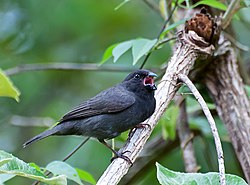| Asemospiza | |
|---|---|
 | |
| Sooty grassquit (Asemospiza fuliginosa) | |
| Scientific classification | |
| Kingdom: | Animalia |
| Phylum: | Chordata |
| Class: | Aves |
| Order: | Passeriformes |
| Family: | Thraupidae |
| Genus: | Asemospiza Burns, Unitt & Mason, 2016 |
| Type species | |
| Fringilla fuliginosa Wied, 1830 | |
| Species | |
See text | |
Asemospiza is a genus of South American birds in the tanager family Thraupidae.

